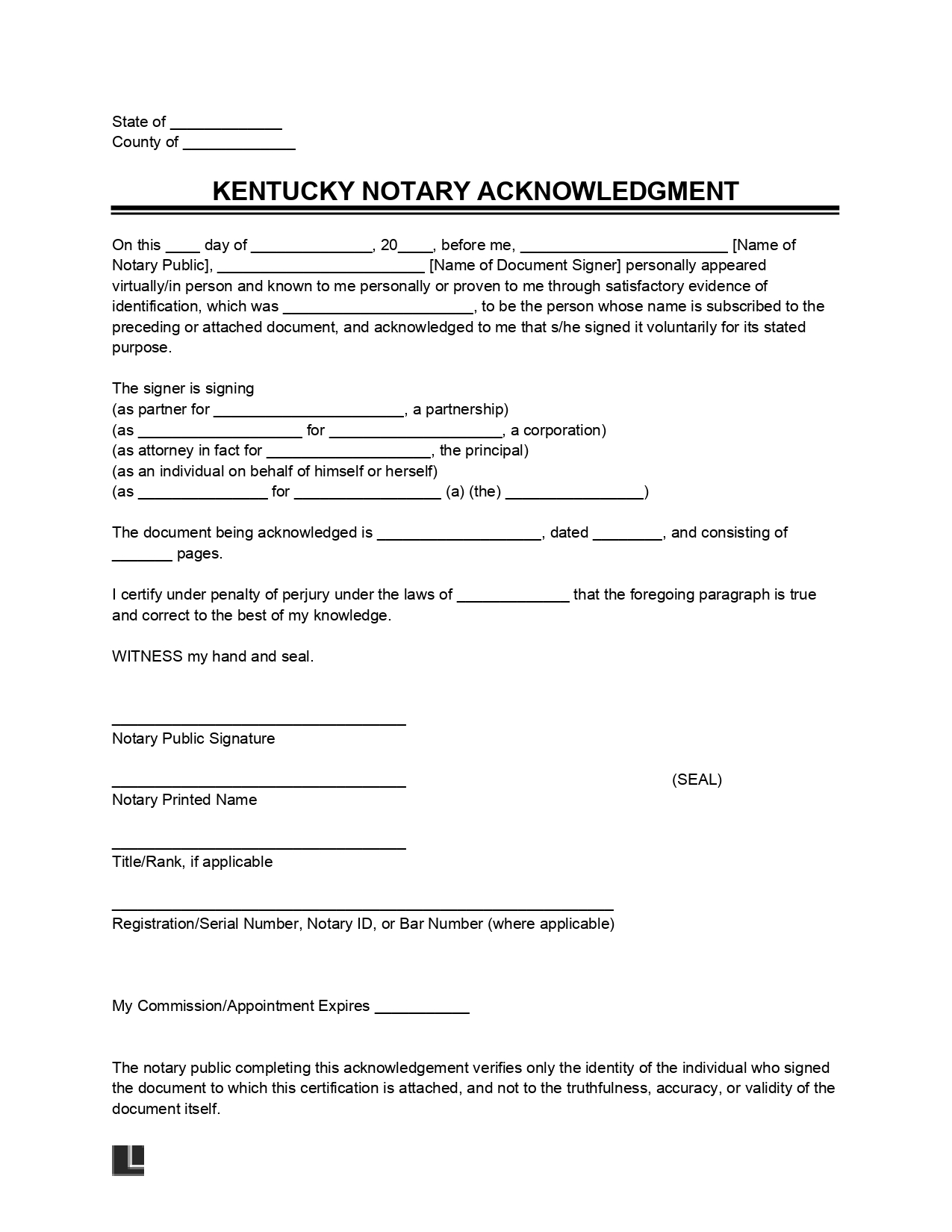A Kentucky notary acknowledgment form is a document that certifies an individual’s signature on a legal document, such as deeds, agreements, affidavits, and powers of attorney. The form includes the notarization date, the parties involved, and a statement that the notary has verified the signer’s identity.
All signing parties must personally appear before the notary public and declare that they have signed the document of free will. Once notarization is complete, the notary’s signature, title, and serial number will be inscribed on each notary acknowledgment form.
Legal Considerations
Statute: § 423.160
Form of Acknowledgment: Must conform to the requirements of KRS 423.110. The certificate must be in a form that is prescribed by the laws or regulations of this state, or by the place where the acknowledgment is taken. Alternatively, the certificate can simply contain the words “acknowledged before me,” or an equivalent phrase that conveys the same meaning.. (§ 423.140)
Notary Term of Commission: Four years (§ 423.390(3))
Notary Handbook: The Notary Public Handbook provides guidelines and regulations for notaries public to follow in fulfilling their duties.
Is Online Notarization Legal in Kentucky?
Yes, online notarization is legal under SB114. According to § 423.455, a remotely located individual can comply with the notarization process by appearing before a notary public via communication technology.
However, the notary public must have personal knowledge of the individual’s identity, have satisfactory evidence of identity, or be able to identify the individual through identity-proofing processes.
The notary public must also create an audio-visual recording of the notarial act, and the certificate must indicate that the act was performed using communication technology. The notary public or a designated repository must retain the recording for at least ten years. Before performing a notarial act facilitated by communication technology, notary publics must notify the Secretary of State and identify the technology being used.
How to Notarize
Step 1 – Find a Notary Public
To notarize a document, you’ll need to find a notary public. Notaries can be found at banks, credit unions, UPS stores, or private notary services.
Step 2 – Present the Document
When you visit the notary, you must present the document you want to notarize. The document should be complete except for the signature fields. If the document only requires an acknowledgment, the signature fields can be completed beforehand.
Step 3 – Appear in Person
All parties involved in signing the document must appear in person before the notary and provide sufficient identification. The notary public may choose to identify an individual through personal recognition.
Step 4 – Sign the Document
Once identities have been verified, signatures can be added to the document. For acknowledgments, each signer must declare they were not coerced or intimidated into signing the document.
Step 5 – Take an Oath or Affirmation
The signer must take an oath or affirmation, swearing to the document’s content. Please note this step does not apply to acknowledgments.
Step 6 – Obtain a Notarial Certificate
After signing the document, the notary public will complete the appropriate notarial certificate. In Kentucky, a seal is not a legal requirement. However, if the document is to be used out of state, it may require a stamp or seal.
How to Verify a Notary
- Go to the Kentucky Notary Search page.
- Filter by county and search by ID or name.
- Click “Search,” and the system will display a list of notaries that match your search criteria.
- Click on the name of the notary you want to verify, and the system will display the notary’s details, such as the date of appointment and if the county clerk has issued a certificate.
How to Write (for Notary)
a. County: The name of the county where the notarization occurs must be entered.
b. Date: The date of the notarization must be entered. This should be the date the signer personally appeared before the notary public.
c. Name of person acknowledged: The full name of the person whose signature is notarized must be entered.
d. Signature of notary: The notary must sign the acknowledgment form with their official signature.
e. Title/rank of notary: The official title or rank must be entered, such as “Notary Public” or “Commissioner of Oaths.”
f. Serial number of notary: The notary’s official serial number must be entered on the form.
g. Seal or stamp of notary (if applicable): If the notary has an official seal or stamp, it should be affixed to the acknowledgment form.


